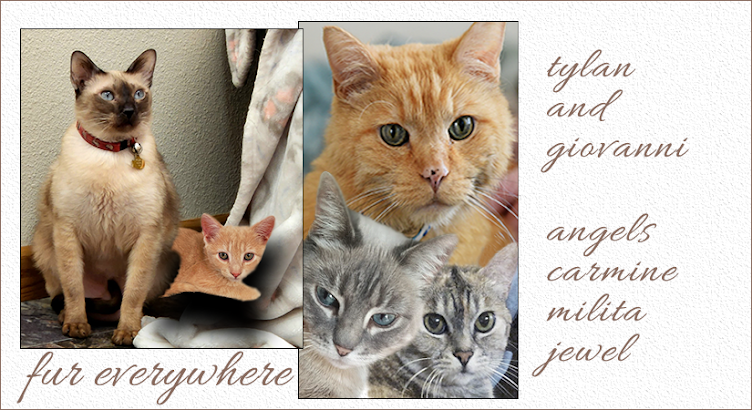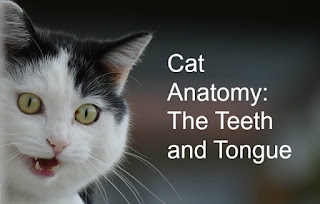Kitten (Deciduous) Teeth
As in humans, cats have two sets of teeth - kitten (deciduous) teeth and adult (permanent) teeth. A kitten's deciduous incisors begin to come in at two weeks of age. At three to four weeks of age, a kitten's canines begin to come in. Deciduous premolars begin to appear when a kitten is between four and six weeks old. All a kitten's baby teeth should be present by the time he is eight weeks old. A kitten has 26 teeth in total.
At 12-16 weeks, a cat's permanent incisors will begin to come in. Premolars, molars, and canines begin to appear between four and six months of age. A cat should have all 30 of her adult teeth in by the time she is seven months of age.
Each tooth consists of two parts - the root and the crown. The crown is the part of the tooth visible above the gums while the root is the part of the tooth that sits below the gums. The roots are attached to the socket (alveolus) of the jaw bone by a ligament known as the periodontal ligament. Some of a cat's teeth only have one root while others, like the upper molars (known as carnassial teeth) have multiple roots.
Each tooth is comprised of the following substances:
- Pulp: At the center of the tooth, the pulp is the only soft tissue in the tooth and contains most of the tooth's blood vessels and nerves. The blood vessels supply the tooth with nourishment. The nerves transmit pain, heat, and cold signals to the brain. That's why damage or inflammation to the pulp is very painful.
- Dentin: Dentin makes up the majority of the tooth and is responsible for giving teeth their white/ivory color. Dentin covers the tooth's pulp and is mostly made up of mineral salts and water.
- Enamel: The enamel is the outer covering on the crown of the tooth. It covers the dentin and is the hardest tissue in the body, according to Pet Place. Enamel is typically pearly white in color and is made up of mineral salts and a small amount of water. The tooth's enamel doesn't contain any nerves. It protects the tooth's dentin. However, a cat's tooth enamel only measures 0.2mm, and damage to the enamel exposes the tooth's dentin, which is very sensitive. Exposed dentin causes a cat a lot of pain.
- Cementum: Cementum covers the dentin along the tooth's root. Usually the cementum meets the enamel where the tooth's root ends and the crown begins. Like enamel, cementum consists of mineral salts and water, and it is as hard as bone.
Types of Cat Teeth
There are four types of teeth in a cat's mouth: incisors, canines, premolars, and molars.
- Incisors: Incisors help bite and hold prey in the cat's mouth. They are the small teeth located in the front of the mouth. A cat has 12 incisors - six on top and six on the bottom of his mouth. Each incisor only has one root. When an incisor becomes diseased, it is often unstable and is easily extracted.
- Canines: Cats have four canines - one on each side in both the top and bottom of their mouths. Canines are utilized in killing and taring prey in the wild.
- Premolars: A cat has six upper premolars (three on each side of its mouth) and four bottom premolars (two on each side of its mouth). The premolars are used in chewing and breaking food into smaller pieces. Because most of the premolars have more than one root, they are harder to extract if they become diseased.
- Molars: The molars' flat surfaces are used to grind food into smaller pieces. A cat has two upper and two lower molars - one on each side of its mouth.
The Tongue
A cat's tongue assists in many daily activities. The tongue helps guide food and water into a cat's mouth, aids in chewing and swallowing, is used for grooming, and tastes a cat's food. Mother cats also use their tongues to stimulate urination and defecation in their kittens by licking their genital areas.
The cat's tongue has filliform papillae. These papillae help him separate the flesh from the bone on prey in the wild. They also aid in grooming by removing dirt and debris from the cat's fur. The papillae are made from keratin, which is also found in human hair and fingernails. When your cat licks you, and you feel a sandpaper-like sensation from his tongue, you are feeling his papillae.
Specialized papillae act as taste buds for cats. A cat's taste buds are cup-shaped toward the back of the tongue and mushroom-shaped at the tip and sides of the tongue. Cats have fewer taste buds than humans do. A cat's tongue is sensitive to temperature and texture as well.
Your kitty's teeth and tongue serve some very important functions. That's why it's so important for your kitty to get regular dental exams and cleanings at the vet. February is Dental Health Month - the perfect time to have your vet check your cat's teeth to ensure they stay healthy.
The cat's tongue has filliform papillae. These papillae help him separate the flesh from the bone on prey in the wild. They also aid in grooming by removing dirt and debris from the cat's fur. The papillae are made from keratin, which is also found in human hair and fingernails. When your cat licks you, and you feel a sandpaper-like sensation from his tongue, you are feeling his papillae.
Specialized papillae act as taste buds for cats. A cat's taste buds are cup-shaped toward the back of the tongue and mushroom-shaped at the tip and sides of the tongue. Cats have fewer taste buds than humans do. A cat's tongue is sensitive to temperature and texture as well.
Your kitty's teeth and tongue serve some very important functions. That's why it's so important for your kitty to get regular dental exams and cleanings at the vet. February is Dental Health Month - the perfect time to have your vet check your cat's teeth to ensure they stay healthy.
Sources:





Very informative post, thank you!
ReplyDeleteGreat post - very informational! You learn something new every day, right? Kitty incisor teeth are so cute and little... they are my favorite! MOL!
ReplyDeleteYup and my mommy said I need a cleaning stat!
ReplyDeleteExcellent post! We didn't know that Angel had a broken tooth, until her dental appt two weeks ago. She's so happy now, and I feel rotten that I did not know. I've learned a lot about cat teeth since then!
ReplyDeleteSo much great info in this post. Thanks for sharing!
ReplyDeleteThere is a lot to kitty teeth, and you covered so much - paws up!
ReplyDeleteThat was an amazingly good post gang!
ReplyDeleteLots of good info here!
ReplyDeleteThis is really interesting and I love the photos that you featured. Purr-fect! ♥
ReplyDeleteGreat post.
ReplyDeleteThat was great! Thanks for the very informative post!
ReplyDeleteGood info, and we learned things we didn't even know! How cool is that?
ReplyDeleteThanks so much for a great post. At the Tomcat home we are all a bit older and Dad pays attention to our toothies. Mr Buttons especially as he has FIV which can exacerbate gum disease.
ReplyDeletePurrs from all
Timmy and Family
Great Article it its really informative and innovative keep us posted with new updates. its was really valuable. thanks a lot.
ReplyDeletetooth sensitivity to cold
Great Article it its really informative and innovative keep us posted with new updates. its was really valuable. thanks a lot.
ReplyDeletetooth sensitivity to cold